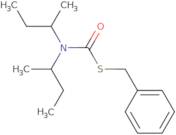S-Benzyl di-Sec-butylthiocarbamate (tiocarbazil)
CAS: 36756-79-3
Ref. 3D-LBA75679
| 10mg | Descatalogado | ||
| 25mg | Descatalogado | ||
| 50mg | Descatalogado | ||
| 100mg | Descatalogado | ||
| 250mg | Descatalogado |
Información del producto
- Brn 1972813
- Carbamic acid, di-sec-butylthio-, S-benzyl ester
- Carbamothioic acid, N,N-bis(1-methylpropyl)-, S-(phenylmethyl) ester
- Carbamothioic acid, bis(1-methylpropyl)-, S-(phenylmethyl) ester
- Caswell No. 082AA
- Drepamon
- EPA Pesticide Chemical Code 110701
- M-3432
- N,N-Di-sec-butyl-S-benzylthiocarbamate
- S-(Phenylmethyl) bis(1-methylpropyl)carbamothioate (9CI)
- Ver más sinónimos
- S-Benzyl N,N-di-sec-butyl thiocarbamate
- S-Benzyl di-sec-butylthiocarbamate
- S-Benzyl-N,N-di-sec-butylthiocarbamate
- S-Phenylmethyl-N,N-bis(1-methylpropyl)carbamothioate
- S-benzyl dibutan-2-ylcarbamothioate
- Thiocarbazil
- Tiocarbazil [BSI:ISO]
- Tiocarbenil
- Triocarbazil
S-Benzyl di-Sec-butylthiocarbamate (tiocarbazil) is a lipophilic compound that has been shown to inhibit the synthesis of fatty acids and cholesterol. It also inhibits the activity of growth regulators in plants. Tiocarbazil has been shown to be an effective herbicide for control of weeds, including those found in rice fields. Tiocarbazil binds to the pyrazole ring of a plant enzyme called 3-hydroxypicolinic acid synthase, which is involved in lipid biosynthesis. The chloride group reacts with the alkylthio group on tiocarbazil, forming a covalent bond with the sulfhydryl group on the active site cysteine residue on 3-hydroxypicolinic acid synthase, thereby inhibiting its activity. This reaction mechanism can be used to explain how tiocarbazil inhibits lipid biosynthesis in plants.





